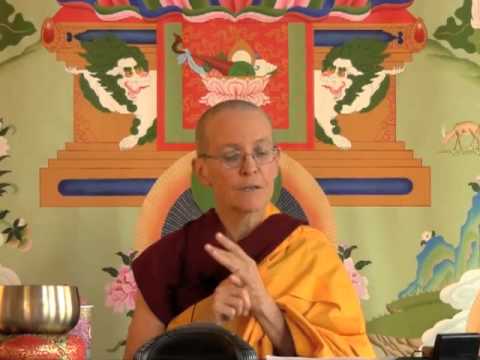Concentration, jhanas, and samadhi
Stages of the Path #121: The Fourth Noble Truth
Part of a series of Bodhisattva’s Breakfast Corner talks on the Stages of the Path (or Lamrim) as described in the Guru Puja text by Panchen Lama I Lobsang Chokyi Gyaltsen.
- How concentration relates to the different upper realms
- Samadhi refers to both meditative states and a mental factor
- The importance of suppressing the five hindrances to attain these meditative states
We’ve been talking about the three higher trainings under the noble truth of the path. We talked about the higher training in ethical conduct, and we’ll start the higher training in concentration now.
In concentration…. It’s described in the lamrim here, but it’s described also, in more depth, under the far reaching attitude of meditative stabilization. Here we’re going to talk about concentration as the jhanas (or what are called dyhanas in Sanskrit, jhana is the Pali term, dyhana is Sanskrit, zen is Japanese, chan is Chinese). That’s how those schools got their names.
Here “jhana” refers to the four form realm absorptions specifically, which are mental states that somebody in the desire realm (we’re in the desire realm) can attain through developing deep meditation and samadhi and shamatha.
Concentration also includes the four formless realm absorptions. Concentration–the term is samadhi– and here it refers to those meditative states.
As a clue, the term “samadhi” does not always refer to those meditative states. The term “samadhi” is also a mental factor that we have right now that just means our ability to concentrate. But our ability to concentrate does not refer to those eight types of samadhi. So, just to distinguish it. Also, the word concentration and samadhi can refer to different types of mental absorptions according to the object. For example, when we talk about the Buddha meditating on the profound illumination on the countless aspects of phenomena, that’s a type of samadhi because of the types of objects that he’s meditating on. Of course, we don’t know what level of samadhi here he’s meditating with, but the object is that, so it’s called a type of samadhi.
Back to talking about the jhanas. To actualize them we have to suppress the five hindrances. “Suppress” is kind of a bad word in psychology, so we have to get over that when we use the word “suppress” here. Here, with these levels of concentration, we are temporarily doing away with (or suppressing) these hindrances, but we aren’t cutting the root off of them. However, by suppressing them temporarily it enables us to access levels of concentration that are very peaceful and blissful, and that can also be used to focus the mind single-pointedly on the nature of reality, and thus to cut (later on when it’s combined with wisdom) cut the afflictions.
The five hindrances that we have to eliminate are sensual desire, malice (or ill will), drowsiness and dullness, restlessness and remorse, and doubt.
Think, in your daily life, how many of your thoughts are caught up with one of those five?
-
How often is our mind involved with sensual desire? What’s for lunch? It’s too cold, I want to be warm. The bed’s too hard, I want it to be soft. Whatever.
-
Ill will. Why did that person do that? They need to do this. Who do they think they are to talk to me that way?
-
Dullness and drowsiness. Either falling asleep in our meditation, or the mind just being dull.
-
Restlessness and remorse. The mind is restless with worry, anxiety, fear. Or it’s filled with remorse and guilt.
-
Then fifth, doubt. The mind is just having doubt about the teachings, doubt about our buddha potential, doubt about the Dharma, my relationship with the Dharma, my relationship with my teacher. Just lots of doubts.
All of those become hindrances to meditating, don’t they? We know that from our own experience. And sometimes we sit down to meditate and we can’t even see those things as hindrances because we’re so used to having them in our minds that we think that they’re the truth, and they’re good, and we need to follow them, because if we don’t follow them we’re going to suffer. It’s true, isn’t it? Isn’t that the way we think? “My doubts are real, I need to follow them.” “My thoughts of malice and ill will are good because they’re going to defend me against people who are going to take advantage of me. And my sensual desires are good because if I don’t get them I’m going to be miserable. And my anxiety is true because I feel it so often, and I don’t know what it’s going to be like not to be anxious.” It’s amazing, isn’t it? It’s so hard for us to even recognize hindrances as hindrances because we’re so familiar with them. So just recognizing them is a step in the right direction.
Tonight our homework is let’s just watch the mind and try and find when the mind is involved in one of those, and label it. Just give it the label. “Sensual desire.” Don’t judge yourself, don’t criticize yourself, just start to label when you notice your thoughts, or your mental state, going in that direction.
Venerable Thubten Chodron
Venerable Chodron emphasizes the practical application of Buddha’s teachings in our daily lives and is especially skilled at explaining them in ways easily understood and practiced by Westerners. She is well known for her warm, humorous, and lucid teachings. She was ordained as a Buddhist nun in 1977 by Kyabje Ling Rinpoche in Dharamsala, India, and in 1986 she received bhikshuni (full) ordination in Taiwan. Read her full bio.


